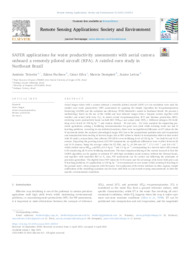SAFER applications for water productivity assessments with aerial camera onboard a remotely piloted aircraft (RPA). A rainfed corn study in Northeast Brazil.
SAFER applications for water productivity assessments with aerial camera onboard a remotely piloted aircraft (RPA). A rainfed corn study in Northeast Brazil.
Author(s): TEIXEIRA, A. H. de C. T.; PACHECO, E. P.; SILVA, C.; DOMPIERI, M. H. G.; LEIVAS, J. F.
Summary: Aerial images taken with a camera onboard a remotely piloted aircraft (ARP) at 4-cm resolution were used for rainfed corn water productivity (WP) assessments by applying the Simple Algorithm for Evapotranspiration Retrieving (SAFER) and the radiation use efficiency (RUE) Monteith’s model in Northeast Brazil. We present a methodology based on the use of the visible and near infrared images from a Sequoia camera together with weather and actual yield data (Ya), to model actual evapotranspiration (ET) and biomass production (BIO), retrieving water productivity based on both BIO (WPBIO) and actual yield (WPYa ). Different nitrogen (N) fertilizing cover levels (0–250 kg ha? 1) and sources (nitrate – Nt and urea – Ur) were analyzed for supporting precision agriculture, aiming a fertilizing recommendation for good corn yield while reducing water use and N leaching problems. According to our statistical analyzes, there were no significant difference on ET values for the N treatments inside the analyzed phenological stages (PS) due to the proportional partition into soil evaporation and transpiration from seeding to harvest stages, but as BIO values is related to transpiration which in turn varied with PS until a certain limit, they affected WP till N cover fertilizing level of 150 kg ha? 1 for both Nt and Ur N sources. Regarding the growing season (GS) WP components, no significant differences were verified between Nt and Ur N sources, being the average values for ET, BIO, and Ya, of 394 mm GS? 1, 17.3 t GS? 1, and 8.8 t GS? 1, which yielded mean WPBIO andWPYa of 4.4 kg m? 3 and 2.2 kg m? 3, corresponding to a harvest index (HI) around 0.50 considering all N cover fertilizing treatments. The most important finding of the current research is that the SAFER algorithm can be applied to estimate ET with high resolution aerial cameras without the thermal bands, and together with modelled BIO or Ya data, WP assessments can be carried out following the principles of precision agriculture. The slightly lower WP values for Ur N source and the advantage of its lower both price and N leaching problems, Ur applications at 150 kg ha? 1 is recommended to save money while avoiding N leaching to the ground water, when compared with Nt source. For replication of the tested methods in other regions, simple calibrations of the modelling equations may be done with field or/and remote sensing measurements, to infer the specific environmental conditions.
Publication year: 2021
Types of publication: Journal article
Keywords: Actual evapotranspiration, Aerial images, Zea mays L
Observation
Some of Embrapa's publications are published as ePub files. To read them, use or download one of the following free software options to your computer or mobile device. Android: Google Play Books; IOS: iBooks; Windows and Linux: Calibre.
Access other publications
Access the Agricultural Research Database (BDPA) to consult Embrapa's full library collection and records.
Visit Embrapa Bookstore to purchase books and other publications sold by Embrapa.

